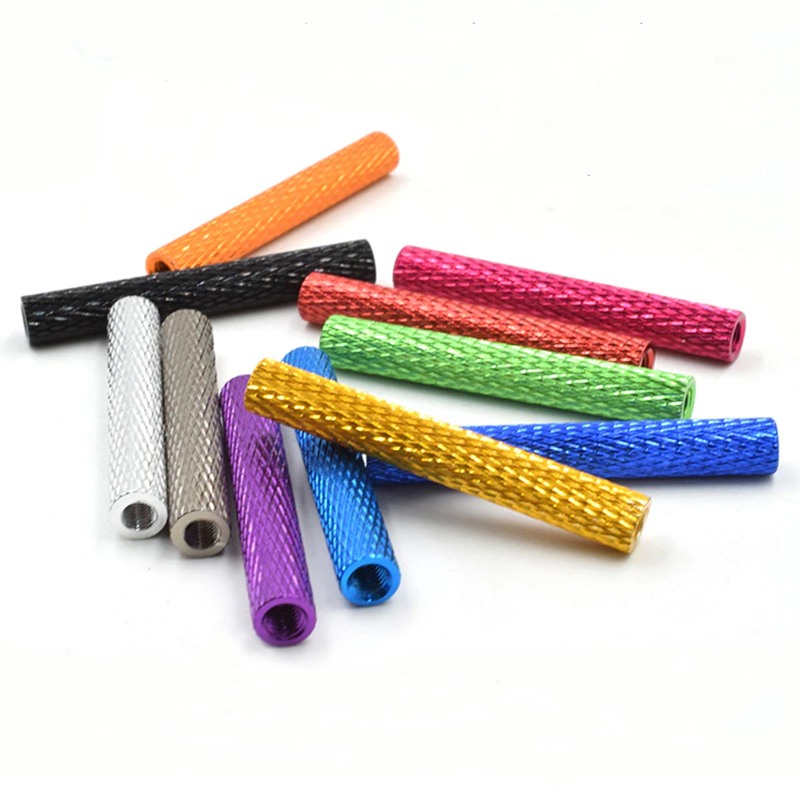1. Definition and Technical Characteristics
A Round Threaded Standoff is a cylindrical fastener with internal and/or external threading, designed to create precise spacing between components in mechanical assemblies. These standoffs maintain structural integrity while allowing for modular component arrangement.

| Characteristic | Technical Specification | Measurement Standards |
|---|---|---|
| Material Composition | Typically aluminum alloy (6061-T6), stainless Steel (304/316), or brass | ASTM B221, ASTM A276 |
| Thread Standards | Metric (M2-M12) or UNC/UNF (4-40 to 1/2-13) | ISO 68-1, ASME B1.1 |
| Length Tolerance | ±0.1mm (precision) to ±0.5mm (standard) | ISO 2768-mK |
| Surface Finish | Ra 0.8-3.2μm (32-125μin) | ISO 1302 |
| Load Capacity | 200-5000N (varies by material and diameter) | ISO 898-1 |
| Temperature Range | -50°C to +150°C (aluminum), -200°C to +400°C (stainless) | MIL-STD-810 |
2. Key Design Features
2.1 Thread Configuration
Round threaded standoffs feature either male-female (threads on both ends), female-female (internal threads at both ends), or male-male (external threads at both ends) configurations. The threading follows precise pitch specifications:
Metric threads: 0.35mm pitch (M2) to 1.75mm pitch (M12)
Unified threads: 0.794mm pitch (4-40) to 1.411mm pitch (1/2-13)
2.2 Dimensional Precision
The cylindrical body maintains tight concentricity tolerances (typically ≤0.05mm TIR) to ensure proper alignment in assemblies. Wall thickness ranges from 0.5mm (small diameters) to 3mm (large diameters), with specific ratios to maintain strength-to-weight optimization.
2.3 Material Properties
Aluminum 6061-T6: Tensile strength 310 MPa, shear strength 207 MPa
Stainless 304: Tensile strength 515 MPa, yield strength 205 MPa
Brass C360: Tensile strength 469 MPa, Rockwell B80 hardness
3. Application Scenarios
3.1 Electronics Industry
In PCB (Printed Circuit Board) assemblies, round threaded standoffs provide critical spacing between boards and chassis:
Server racks: M4 standoffs with 10-50mm lengths maintain 3U to 5U spacing
Consumer electronics: M2.5 standoffs create 5-15mm air gaps for thermal management
RF equipment: Brass standoffs provide EMI shielding with 0.5mm wall thickness
3.2 Mechanical Engineering
Precision machinery utilizes standoffs for component positioning:
Optical systems: 6mm diameter standoffs with ±0.02mm length tolerance
Robotic arms: Stainless Steel standoffs withstand 2000N dynamic loads
Automotive sensors: High-temperature standoffs maintain -40°C to +125°C operation
3.3 Aerospace Applications
Specialized standoffs meet stringent aerospace requirements:
Avionics: MIL-SPEC standoffs with NASM21227 compliance
Satellite systems: Aluminum standoffs with 0.8:1 length-to-diameter ratio
Cockpit instruments: Vibration-resistant designs with 50g shock rating
4. Maintenance and Care Procedures
4.1 Installation Best Practices
Apply thread-locking compound (Loctite 242 for <2N·m, 271 for >5N·m torque)
Use calibrated torque wrenches: 0.1-0.3N·m for M2, 5-8N·m for M8 standoffs
Maintain perpendicularity within 2° during installation
4.2 Routine Maintenance
Inspect threads every 6-12 months using ISO 1502 thread gauges
Clean with isopropyl alcohol (99.9% purity) for electronics applications
Check for galvanic corrosion in dissimilar metal pairings
4.3 Environmental Protection
Apply MIL-PRF-23377 epoxy coating for salt spray resistance (>500 hours)
Use passivated stainless steel (ASTM A967) for chemical exposure
Implement conductive anodizing (Type II, 0.02-0.04mm) for ESD protection
5. Failure Prevention
Common failure modes and mitigation strategies:
Thread stripping: Maintain engagement length ≥1.5× diameter
Fatigue cracking: Replace standoffs after 106 stress cycles
Thermal expansion: Allow 0.1mm clearance per 100°C ΔT for aluminum
Creep deformation: Limit sustained loads to ≤60% of yield strength





 English
English

